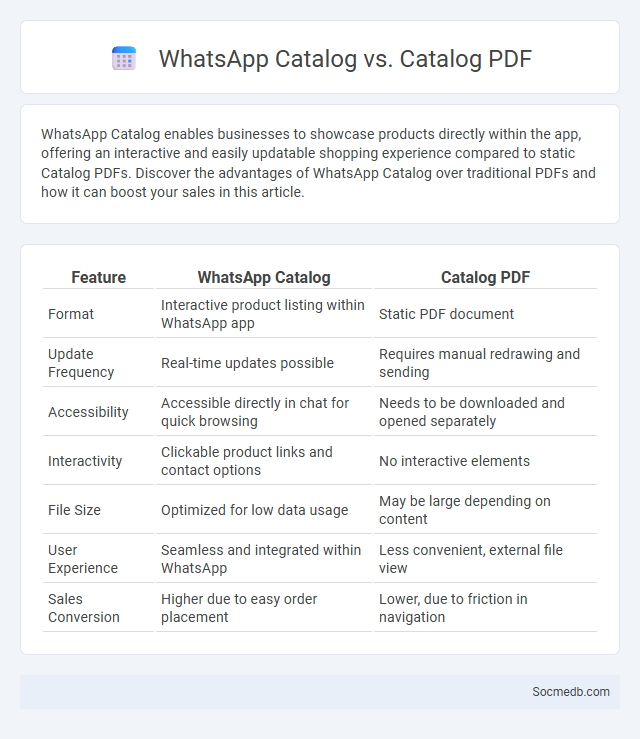
Photo illustration: WhatsApp Catalog vs Catalog PDF
WhatsApp Catalog enables businesses to showcase products directly within the app, offering an interactive and easily updatable shopping experience compared to static Catalog PDFs. Discover the advantages of WhatsApp Catalog over traditional PDFs and how it can boost your sales in this article.
Table of Comparison
| Feature | WhatsApp Catalog | Catalog PDF |
|---|---|---|
| Format | Interactive product listing within WhatsApp app | Static PDF document |
| Update Frequency | Real-time updates possible | Requires manual redrawing and sending |
| Accessibility | Accessible directly in chat for quick browsing | Needs to be downloaded and opened separately |
| Interactivity | Clickable product links and contact options | No interactive elements |
| File Size | Optimized for low data usage | May be large depending on content |
| User Experience | Seamless and integrated within WhatsApp | Less convenient, external file view |
| Sales Conversion | Higher due to easy order placement | Lower, due to friction in navigation |
Overview of WhatsApp Catalog
WhatsApp Catalog enables businesses to showcase products directly within the app, streamlining customer browsing and purchasing processes. Your catalog displays high-quality images, descriptions, and prices, making it easier for potential buyers to explore offerings at their convenience. This feature enhances customer engagement by providing a seamless shopping experience without leaving the chat platform.
Features and Benefits of WhatsApp Catalog
WhatsApp Catalog enables businesses to showcase products or services directly within the app, offering a seamless shopping experience for your customers. It allows you to create organized product listings with images, descriptions, and prices, simplifying customer browsing and decision-making. Using this feature enhances your visibility, saves time on customer inquiries, and drives sales through mobile-friendly interactions.
What Is a Catalog PDF?
A catalog PDF is a digital document that organizes products or services into a structured format for easy browsing and reference on social media platforms. It allows you to showcase item descriptions, prices, and images, enhancing user engagement and facilitating direct purchases or inquiries. Utilizing a catalog PDF can significantly improve your social media marketing strategy by providing a professional and accessible way to present your offerings.
Pros and Cons of Catalog PDFs
Catalog PDFs offer an efficient way to showcase products with high-resolution images and detailed descriptions, enhancing your social media campaigns by providing easily shareable content. However, they may suffer from limited interactivity and slower loading times on mobile devices, potentially reducing user engagement and reach. Balancing the visual appeal and accessibility of your catalog PDFs is crucial for maximizing their effectiveness on social media platforms.
Traditional Catalog: Definition and Uses
Traditional catalogs are printed collections of products or services organized for easy browsing and purchasing, often distributed by mail or available in stores. These catalogs serve as tactile marketing tools that enhance brand recognition and provide detailed information, allowing you to explore offerings without an internet connection. Leveraging traditional catalogs alongside social media campaigns can strengthen multi-channel marketing strategies and reach a wider audience effectively.
Key Differences: WhatsApp Catalog vs. Catalog PDF vs. Catalog
WhatsApp Catalog enables businesses to showcase products directly within the app, offering interactive, up-to-date listings that customers can browse and order from instantly. Catalog PDF provides a static, downloadable format suitable for offline sharing but lacks real-time updates and direct purchasing features. A traditional Catalog encompasses broader marketing materials, often multi-channel, combining detailed product descriptions with imagery, whereas WhatsApp Catalog integrates seamless communication and commerce within a mobile messaging environment.
User Experience Comparison
Social media platforms excel in user experience through intuitive interfaces, fast load times, and personalized content algorithms that increase engagement. Features such as seamless navigation, real-time updates, and integrated multimedia support enhance user satisfaction and retention. Mobile optimization and accessibility options are critical factors driving the comparative advantages of leading social networks like Instagram, Twitter, and TikTok.
Business Use Cases for Each Catalog Type
Social media platforms offer distinct business use cases tailored to each catalog type: product catalogs drive e-commerce by showcasing inventory with detailed descriptions and pricing, enhancing customer purchase decisions; service catalogs enable companies to highlight consulting, repair, or subscription offerings with clear service tiers and benefits; event catalogs facilitate promotion and registration for webinars, workshops, or conferences, increasing attendee engagement and lead generation. Leveraging platform-specific features like shoppable posts on Instagram, service booking tools on Facebook, and event pages on LinkedIn maximizes visibility and conversion for each catalog type. Data analytics from these catalogs help businesses optimize marketing strategies by tracking customer interactions, campaign performance, and sales metrics.
Cost and Maintenance Considerations
Social media platforms require ongoing investment in content creation, advertising budgets, and analytic tools to maintain visibility and engagement. Costs vary depending on campaign scale, platform algorithms, and targeted demographics, impacting overall return on investment (ROI). Regular updates and monitoring are essential to adapting strategies, minimizing risks, and optimizing marketing expenditures.
Choosing the Right Catalog Format for Your Business
Selecting the appropriate catalog format for your business on social media enhances product visibility and user engagement by aligning with platform-specific features such as Instagram Shops or Facebook Marketplace. Optimize your catalog by integrating high-quality images, accurate product descriptions, and updated pricing to drive conversions and support targeted advertising campaigns. Leveraging dynamic catalogs enables real-time inventory updates, improving customer experience and boosting sales efficiency across social media channels.
 socmedb.com
socmedb.com